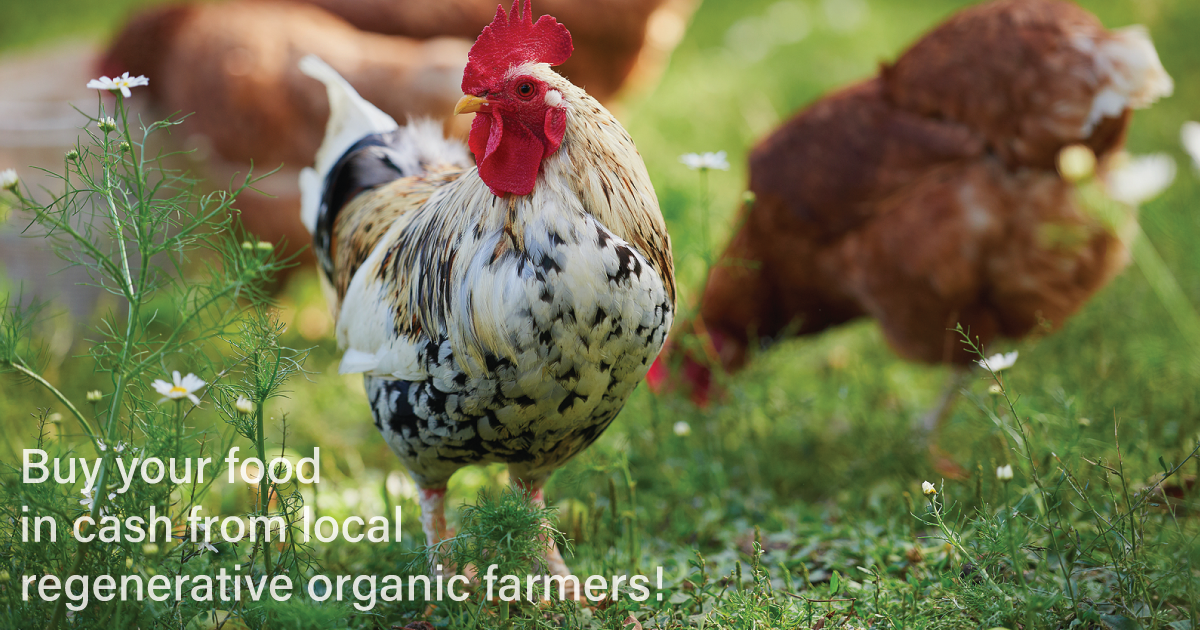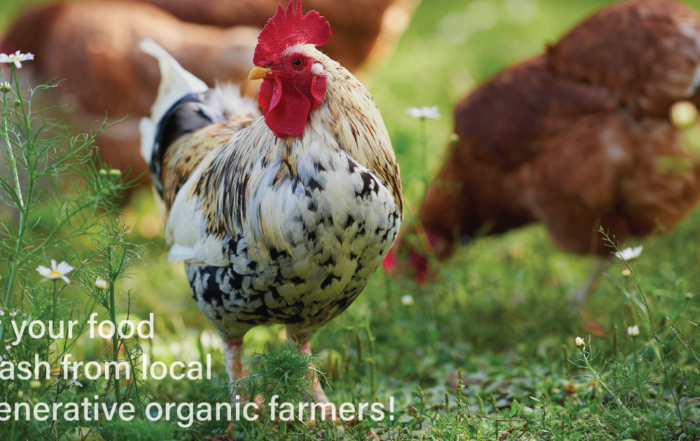Spending Millions of Dollars Killing Millions of Farm Animals Is Wrongheaded, Cruel and Could Cause the Food Crisis That Billionaires Will Use to Scare Us Into Digital Prisons
April 17, 2024 | by Alexis Baden-Mayer
Organic Consumers Association
Fill your freezer with regenerative organic meat. Buy eggs and milk, and get backyard chickens, while you can, because the bird food crisis has already begun:
Dairy herds in eight U.S. states have tested positive for the bird flu: Idaho, Kansas, Michigan, New Mexico, North Carolina, Ohio, Texas and South Dakota.
There are now 17 states that are rejecting cattle from those states: Alabama, Arizona, Arkansas, California, Delaware, Florida, Hawaii, Idaho, Kentucky, Louisiana, Mississippi, Nebraska, North Carolina, Pennsylvania, Tennessee, Utah, and West Virginia.
Blocking cattle from being moved across state lines means preventing cattle from being slaughtered.
Nebraska is the number-one state for beef slaughter. It processes 7.5 million carcasses each year. It’s also a top feedlot producer, with 1.8 million cows raised in the state. But that means 5.7 million cattle come from other states into Nebraska to be slaughtered each year.
Blocking this flow of cattle will cause massive chaos and disruptions to the food supply.
We got a taste of this during COVID, but it was largely a false alarm.
In May 2020, in an article titled, “Millions of US farm animals to be culled by suffocation, drowning and shooting,” the Guardian reported that an estimated 10 million chickens had been culled “either at the chick or egg stage” due to Covid-19-related slaughterhouse shutdowns, and that an additional 2,061,000 chickens were killed on the farm.
In the same article, based on projections from the pork industry, the Guardian estimated that 2 million pigs had been euthanized and predicted 10,069,000 more would face the same fate.
But, the dreaded bacopalypse did not come to pass. According to a 2022 U.S. Department of Agriculture report, “Overall, total hog slaughter in 2020 exceeded 2019 levels, despite most regions experiencing a multi-month decline following the onset of the COVID-19 pandemic.”
That didn’t stop bacon prices from hitting all-time highs. (Along with huge increases in poverty and food insecurity, COVID facilitated a massive transfer of wealth to the billionaires.)
Now, with bird flu pandemic hysteria cranking up a notch each day, we should brace ourselves for something even worse. It’s being rolled out from the get-go with the makings of a massive food crisis.
Undoubtedly, whatever happens with the bird flu, it will involve tactics aimed at getting people to take vaccines (see John Fleetwood’s “As Media Hypes Bird Flu-Infected Cows, Bird Flu Vaccine Discovered to Contain Neurotoxin Mercury, Dog DNA, Cancer-Causing Chemicals: FDA Package Insert”) and drugs like Tamiflu “just in case.”
But, the biggest impact of the bird flu might be on how and what we eat.
When asymptomatic birds test positive for the flu, the government pays the farmer to cull the whole flock. That’s been going on since the 1980s, and while it has surely aided the consolidation of the poultry industry and raised chicken and egg prices, it hasn’t made a dent in production. We just see fewer larger farms raising ever more chickens.
No such program exists for dairy cows, so these 17 states rejecting cattle from states with bovine avian influenza, will cause real chaos and disruptions to the food supply.
What will happen next is anyone’s guess, but here are a few things we now know about the decades of bird flu fear-mongering and propaganda:
- Spending millions of dollars to kill millions of chickens hasn’t worked.
The bird flu pandemic has been going on for decades, but it’s only affected poultry, so the cruelty, waste and illogic of the bird flu response—destroying flocks that are asymptomatic when one bird tests positive—has garnered little attention.
Joel Salatin, quoted in a recent article by Dr. Joseph Mercola explains why this policy is so insane:
“‘The policy of mass extermination without regard to immunity, without even researching why some birds flourish while all around are dying, is insane. The most fundamental principles of animal husbandry and breeding demand that farmers select for healthy immune systems.’” …
“The answer is relatively simple. Save birds that survive the infection and breed them. That way, future generations will have natural immunity. ‘If a flock gets HPAI, let it run its course. It’ll kill the ones it’ll kill but in a few days the survivors will be obvious. Keep those and put them in a breeding program,’ Salatin writes.”
That’s what Will Harris of White Oak Pastures did. He raises healthy animals outdoors. In a recent video he makes the case that regenerative organic farmers have no reason to fear the bird flu. He has evidence from tests of his flocks that they stayed asymptomatic after exposure, because they are healthy and have functioning immune systems.
Mass killings don’t make a lick of sense, but that’s what’s been happening for 25 years as a national program and since the 1980s at the state level.
Since 2000, there’s been a national program to test farmed poultry under the National Poultry Improvement Plan’s “U.S. Avian Influenza Clean” program. There were state programs for universal bird flu testing that predate the national program.
Highly Pathogenic Avian Influenza was considered a threat to egg, chicken and turkey farming, but HPAI did not exist in the United States, so the program tested for Low Pathogenic Avian Influenza, which caused few or no clinical signs in infected birds.
Even though they weren’t sick, birds that tested positive for LPAI were culled, based on the idea that the H5/H7 subtypes of low pathogenic avian influenza could mutate into highly pathogenic avian influenza.
An outbreak in 1983–1984 prompted the destruction of more than 17 million birds at a cost of nearly $56 million. The involvement of gain-of-function hall-of-shamer Yoshihiro Kawaoka in this incident and the fact that it predated the politically suspicious 1997 Hong Kong outbreak where there were human bird flu cases suggest that there’s more to this story than most people realized.
In 1996–1997, a number of table-egg farms in Pennsylvania tested positive for an H7N2 avian influenza virus that was nonpathogenic to chickens, but the Pennsylvania Agricultural Department ordered nine flocks to be depopulated.
In 2002, nearly 4 million birds were killed under State and Federal authority in Virginia and Texas due to outbreaks of H7 LPAI (in Virginia) and H5 LPAI (in Texas). The U.S. Department of Agriculture’s APHIS provided compensation to the poultry owners and contract growers at the rate of $10 per bird, spending close to $40 million on the effort.
In 2006, the national test-and-destroy program was expanded from breeding flocks to commercial poultry.
Spending millions of dollars killing millions of otherwise healthy birds every time a flock tested positive for Low Pathogenic Avian Influenza, didn’t keep Highly Pathogenic Avian Influenza at bay.
In 2015, HPAI H5 virus outbreaks (including H5N2 and H5N8 viruses) were reported for the first time in U.S. poultry flocks, impacting 21 states. According to the inappropriately titled, “When poultry take a sick leave: Response costs for the 2014–2015 highly pathogenic avian influenza epidemic in the USA,” $879 million was spent to kill 51 million birds.
In 2016, 414,000 birds were killed after they tested positive for H7N8 HPAI/LPAI in Indiana.
In 2017, HPAI was found in Tennessee; 253,000 birds with LPAI were killed in four states including Alabama, Kentucky and Georgia.
In 2020, a South Carolina turkey flock with 32,577 birds was destroyed after HPAI was detected.
- Killing asymptomatic birds is cruel and unnecessary.
In 2021, the Humane Society of the United States, Mercy for Animals and Farm Sanctuary challenged the United States Department of Agriculture’s avian influenza response plan and won a settlement. According to Farm Sanctuary:
“USDA’s cruel and irresponsible plan relies on and incentivizes “depopulation” (the mass slaughter of innocent animals) to contain bird flu outbreaks rather than doing anything to address the stressful and overcrowded factory farm conditions that make such outbreaks virtually inevitable.
“The USDA sought to dismiss the lawsuit, but a California federal judge ordered in March 2021 that the case should move forward, and ultimately, the parties were able to reach a settlement. While this victory will not immediately stop the mass killings of birds on factory farms or prevent the agency from spending hundreds of millions of taxpayer dollars bailing out agribusiness when flocks are ‘depopulated,’ it will require USDA to produce an Environmental Impact Statement (EIS) addressing the devastating impacts of a plan that involves killing millions of birds and disposing of their bodies in unlined pits or burning them.
“We hope the agency will realize the foolishness of its plan and adopt an alternative that seeks to prevent bird flu outbreaks in the first place by addressing the horrendous overcrowded conditions in factory farms, as suggested in our lawsuit. Adopting such an alternative could stop the senseless killing of tens of millions of animals and save taxpayers hundreds of millions of dollars.”
In January 2023, the USDA published a Notice of Intent to Prepare an Environmental Impact Statement for Highly Pathogenic Avian Influenza, but has not yet taken further action.
Meanwhile, we’re in the midst of the largest ever destruction of flocks in history, which has been ongoing since 2022, with 88.17 million birds killed as of April 16, 2024.
These birds are not dying from the flu. They’re asymptomatic, they’re being massacred and the more birds are killed the more HPAI cases there are.
One hint that this is a scam is that the government and their stenographers in the media never mention how many birds die from the flu versus being killed for testing positive. Since we never hear about birds dying from the flu, we can only assume that all the birds being killed are asymptomatic.
- Farmers aren’t complaining about killing asymptomatic birds, because they’re getting paid to do it.
The government is guaranteeing farmers and poultry companies market prices and disposal costs when they destroy their flocks. It’s hard not to see that as a perverse incentive for an industry that’s been getting bigger in a way that could only crash prices.
The Environmental Working Group reports that the largest chicken farms increased by 17 percent, from 6,332 farms with 500,000 or more birds in 2012 to 7,406 farms in 2022.
There were 24 percent more chickens produced in these facilities in 2022 than in 2012–almost 1.4 billion more.
At the same time, the number of farms raising broiler chickens shrunk between 2012 and 2022, decreasing three percent from 32,935 broiler chicken farms in 2012 to 31,877 in 2022.
More birds have been concentrated into fewer broiler operations because at the same time that the number of farms went down by three percent, the number of animals increased by eight percent, from almost 8.5 billion birds in 2012 to almost 9.2 billion in 2022.
Farming is a notoriously high-risk, low-margin enterprise and poultry farmers are serfs on their own land caught in terribly abusive contracts with the chicken companies. Faced with testing positive for HPAI, no farmer would be able to refuse a buyout in exchange for destroying the flock.
That’s why we aren’t hearing poultry farmers complain about any of this.
- The egg and chicken companies aren’t complaining because they’re benefiting from higher prices, even as quality drops. They don’t care if people go hungry.
COVID increased hunger. The cruel and wasteful bird flu strategy of killing asymptomatic birds could cause an even worse food crisis. Already, prices are rising.
Yahoo is reporting, “Eggs jumped to $3 per dozen in 2024, double the cost of $1.45 in February 2020. However, prices are down from 2023, when a dozen eggs cost $4.82, according to USA Today statistics.”
Fox News says, “Boneless chicken breast has increased in price 26%, from $3.26 per pound in January 2021 to $4.11 per pound in February 2024.”
Low supply means higher prices and lower quality.
Chick-fil-A is dropping a decade-old “no antibiotics ever” pledge, claiming they just can’t source enough antibiotic-free chicken. Do they mean, at the right price?
- Higher egg and chicken prices, and lower quality, could make Frankenfoods more competitive.
While conscientious animal advocates are pressing the USDA to invest in higher-welfare farming to keep flocks healthy, Frankenfood vegans are cheering on HPAI, despite the mass killings, celebrating what they see as the inevitable triumph of synthetic genetically modified organisms over animal farming.
Factory farming is awful and it’s hard to be sympathetic to people in that industry, but synthetic biology and lab-grown meat aren’t any better. That switch would leave control of the food system in the hands of the exact same companies and evil billionaire investors–except with a tighter grip–and I wouldn’t put it past them to exaggerate, exacerbate or even plan a bird flu crisis to accomplish their goal of driving the last remaining independent farmers out of business and replacing real farms with fake food.
If that doesn’t seem possible to you, watch “The Hostile Takeover of Food Production,” an interview Christian Westbrook of Ice Age Farmer did with Dr. Frédéric Leroy, a Belgian professor of food science and biotechnology.
They confirm that it isn’t idealistic vegans who are driving the transition from real farms to fake food, it’s a well-coordinated and very powerful network of the super-rich who have nothing less than world domination as their goal. This is the same conclusion I came to when I reviewed the history of the fake meat movement for my presentation on The Plot to End Farming.
In 2019, the World Economic Forum projected that one-third of the global meat supply would be displaced by fake meat within 10 years, in 20 years that would double to 60 percent, and “the disruptive effect of new biotechnology methods will go beyond meat into milk, egg white, gelatine and fish products.”
The World Economic Forum and the Bill & Melinda Gates Foundation co-hosted the high-level 2019 COVID rehearsal Event 201, organized by the Johns Hopkins Center for Health Security. That timely and eerily predictive tabletop exercise was funded by Facebook co-founder Dustin Moskovitz’s Open Philanthropy.
So, we have every reason to be concerned that, at its annual meeting in Davos this year, the World Economic Forum was “Preparing for Disease X.”
Could the bird flu be used as an excuse to shut down animal farming altogether?
From the perspective of the business interests and billionaires behind the World Economic Forum, that would be the perfect way to force a shift from real farms to fake food.
And, food rationing might be the easiest way for them to get people to adopt digital ID in anticipation of the imposition of central bank digital currency (CBDC).
As Christian Westbrook reported in 2022, this has already happened in Iran (“IRAN: Digital Food Rationing rolls out using Biometric IDs amid food riots”).
And, in the U.S., it’s already happened to people who rely on SNAP (the Supplemental Nutrition Assistance Program), as you can see on the Digital Identity page of the Digital Benefits Hub, a think tank run out of Georgetown University’s Tech & Society, funded by Schmidt Futures, the Bill & Melinda Gates Foundation, the Open Philanthropy Project and the Rockefeller Foundation.
It’s not too late to stop this and there is only one way to do it: Buy your food in cash from local farms!
Related Posts
Spending Millions of Dollars Killing Millions of Farm Animals Is Wrongheaded, Cruel and Could Cause the Food Crisis That Billionaires Will Use to Scare Us Into Digital Prisons
April 17, 2024 | by Alexis Baden-Mayer Organic Consumers Association Fill your freezer with regenerative organic meat. Buy eggs and milk, and
About Equal Exchange Fresh Produce
Source: Equal Exchange Fairtrade. Organic. Small Farmer Grown. Equal Exchange produce is unconventional. It’s not just that it is organic and Fairtrade, the Equal Exchange produce supply chain is a genuine departure
Toxic Timeline: A Brief History of PFAS
Research in the 1940s and ’50s led to the commercialization and widespread use of PFAS, substances that are now found in the bloodstream of almost all Americans. February 19, 2019 | Source:




